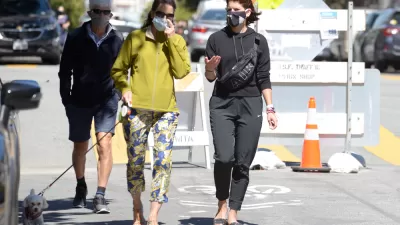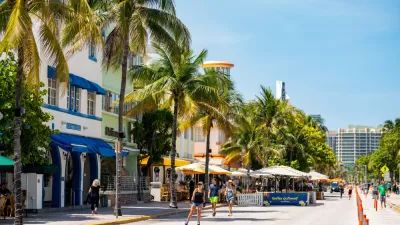Residents in Pacific Beach want the city to revise its design of the Diamond Street ‘slow street,’ the last remaining segment of pandemic-era pedestrian-oriented road in the city.

“San Diego’s controversial two-year experiment with ‘slow streets’ suffered another setback this week when Pacific Beach leaders demanded major changes to the only slow street segment that had been popular enough to survive,” reports David Garrick.
“Pacific Beach leaders say the benefits of having a new safe space to exercise and strengthen bonds among neighbors was outweighed by the city’s poor rollout of the program, confusion about the rules and poor treatment of residents.” According to planning group member Scott Chipman, “We need a comprehensive plan, not just the city throwing a couple signs out to say this street is now a park and you residents have to deal with it.”
“Wednesday’s hearing featured 16 speakers in favor of the slow street and 16 speakers against, said [Marcella Bothwell, leader of the Pacific Beach Town Council], suggesting the experiment could work with some upgrades and different behavior from users of the slow street.” While some residents brought up disrespectful behavior from the street's users, some opponents worry that Diamond Street would receive the same controversial bike lane treatment as Gold Coast Drive. “On Mira Mesa’s Gold Coast Drive, city officials did some re-striping in early April that created new bike lanes on either side of the road, with one vehicle lane in the center to handle car traffic in both directions.” But the design confused and angered some residents who felt the city didn’t provide enough notice and who feared an increased risk of head-on collisions.
Opposition to the city’s ‘slow streets’ implementation isn’t always just about drivers. “Community leaders in San Ysidro wanted a more permanent paseo instead of a slow street segment,” for example. “City officials say the program has taught them what works, what doesn’t work and how to cooperate with residents and neighborhood leaders on future slow streets projects. But the recent uproar in Mira Mesa raises questions about that.”
FULL STORY: San Diego’s only surviving ‘slow street’ facing new backlash, demands for safety upgrades

Alabama: Trump Terminates Settlements for Black Communities Harmed By Raw Sewage
Trump deemed the landmark civil rights agreement “illegal DEI and environmental justice policy.”

Planetizen Federal Action Tracker
A weekly monitor of how Trump’s orders and actions are impacting planners and planning in America.

The 120 Year Old Tiny Home Villages That Sheltered San Francisco’s Earthquake Refugees
More than a century ago, San Francisco mobilized to house thousands of residents displaced by the 1906 earthquake. Could their strategy offer a model for the present?

Ken Jennings Launches Transit Web Series
The Jeopardy champ wants you to ride public transit.

BLM To Rescind Public Lands Rule
The change will downgrade conservation, once again putting federal land at risk for mining and other extractive uses.

Indy Neighborhood Group Builds Temporary Multi-Use Path
Community members, aided in part by funding from the city, repurposed a vehicle lane to create a protected bike and pedestrian path for the summer season.
Urban Design for Planners 1: Software Tools
This six-course series explores essential urban design concepts using open source software and equips planners with the tools they need to participate fully in the urban design process.
Planning for Universal Design
Learn the tools for implementing Universal Design in planning regulations.
Clanton & Associates, Inc.
Jessamine County Fiscal Court
Institute for Housing and Urban Development Studies (IHS)
City of Grandview
Harvard GSD Executive Education
Toledo-Lucas County Plan Commissions
Salt Lake City
NYU Wagner Graduate School of Public Service





























